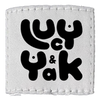I thought we might as well start with the big one. We all love cotton. So soft, flexible, comfortable. It conjures images of white cleanness and the open grasslands of the American Dream. If this was a film, that's when they'd put in the sound of a record coming to an abrupt halt. The story of cotton doesn't really go like that at all.
How is cotton grown?
It's true that a lot of cotton is still grown in America. The other big exporters are China, India, Brazil, Australia and Uzbekistan. It's a pretty interesting plant; when it was brought to Europe people imagined that the cotton tree must have tiny lambs living in the ends of its branches and that the cotton was the lambs' wool. Most cotton is produced from shrubs rather than trees, but that description captures the lovely fluffiness of the cotton on the plant.
People have been growing, spinning and making fabric with cotton for millennia. The earliest evidence found so far is from the 5th millennia BC so it's not so surprising it is so ubiquitous in our clothing and textiles. The problems only really started getting big with the industrial revolution. Whilst the introduction of machinery meant vast quantities of fabric of a consistent quality could be produced quickly, providing inexpensive clothing for many, it also took away work from hundreds of individuals. And if the price is too low the factory workers don't get paid a fair wage.
Not only this, but demand increased for the raw product so that pesticides became much more important in the growth process, ensuring that the vast quantities demanded could be reliably provided.
Perhaps the biggest impact of the huge demand for cotton is the need to grow it in places that don't really support this type of crop. Which is to say, they don't have enough rain. For a plant to grow, good quality cotton it needs loads of water so in places without loads of rain it is necessary to irrigate. In some cases (like the Aral Sea which I mentioned in my previous post) this means diverting whole rivers. This is devastating for the environment.
If producers then throw pesticides in that water, any waste water coming out of the factories is going to kill the ecosystem to which it returns. Add to that the waste from the dyeing process and you see the type of problems that those living alongside the Citarum River in Indonesia. People have to wash and use the water for cooking. It is one of the most polluted rivers in the world. The health consequences are horrific, affecting the five million people who live in the river basin. Five million people!
What we can do
This really makes it clear why growing cotton organically is so important. Without the pesticides there is a much less significant environmental impact. That said, the impact is still significant and it's still important to clean up the dyeing process and the treatment of water coming out of the process to protect people and wildlife around the factories that are processing cotton.
This is why using a GOTS certified producer is so important (like we do for our Organic Originals). GOTS regulate how the cotton is grown and also what dyes are used, along with making sure they are disposed of correctly. They also focus on water usage and keeping this as low as possible.
Cotton does have some fantastic qualities, it is bio-degradable, this is why we love it over and above synthetic fibres. There are other ways to start reducing the impact of our love for cotton. Recycling and reusing is a big one, but so are the wide range of other fabrics that are becoming more available and which can also be used in combination with fibres like cotton to reach a compromise that doesn't compromise the wellbeing of those living and working in and around the clothing industry.
The main issue with cotton is the industrial sized production of it, and this is where fast, cheap fashion is causing the problems. We don't have to shun cotton completely, we just need to buy things that are good quality and that last.

Compressed Bales of Organic cotton waiting to be spun into Organic Yarn
We are planning to go and visit the farms where our cotton is produced, to meet the farmer and learn more about how this crop is grown. We will be heading there armed with many questions for the farmer. We only use GOTS certified cotton, so we know there are regulations set by them, but we want to see it for ourselves.
We have also been talking to our supplier about using recycled cotton, he is working on this for us. It's possible, so this is very exciting. We will keep you updated with our progress. Next time we will look at a fabric that we have been working with for our new winter collection: Recycled Polyester.


Images of Organic cotton at different stages courtesy of our supplier: Herbal Fab
As always if you have any feedback please let us know, we try to find information that is as accurate as possible, but if you think we missed something or misrepresented anything please let us know.

